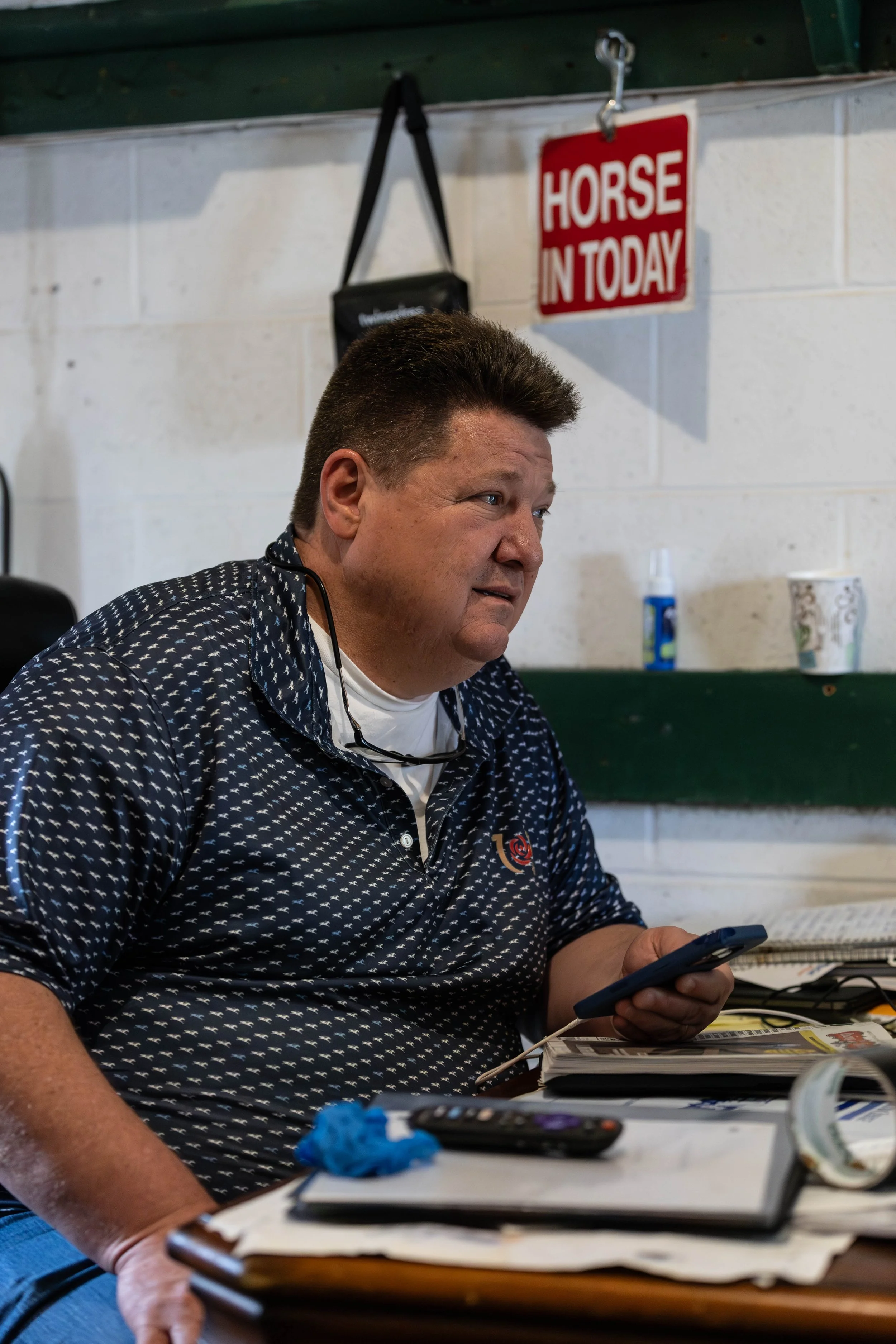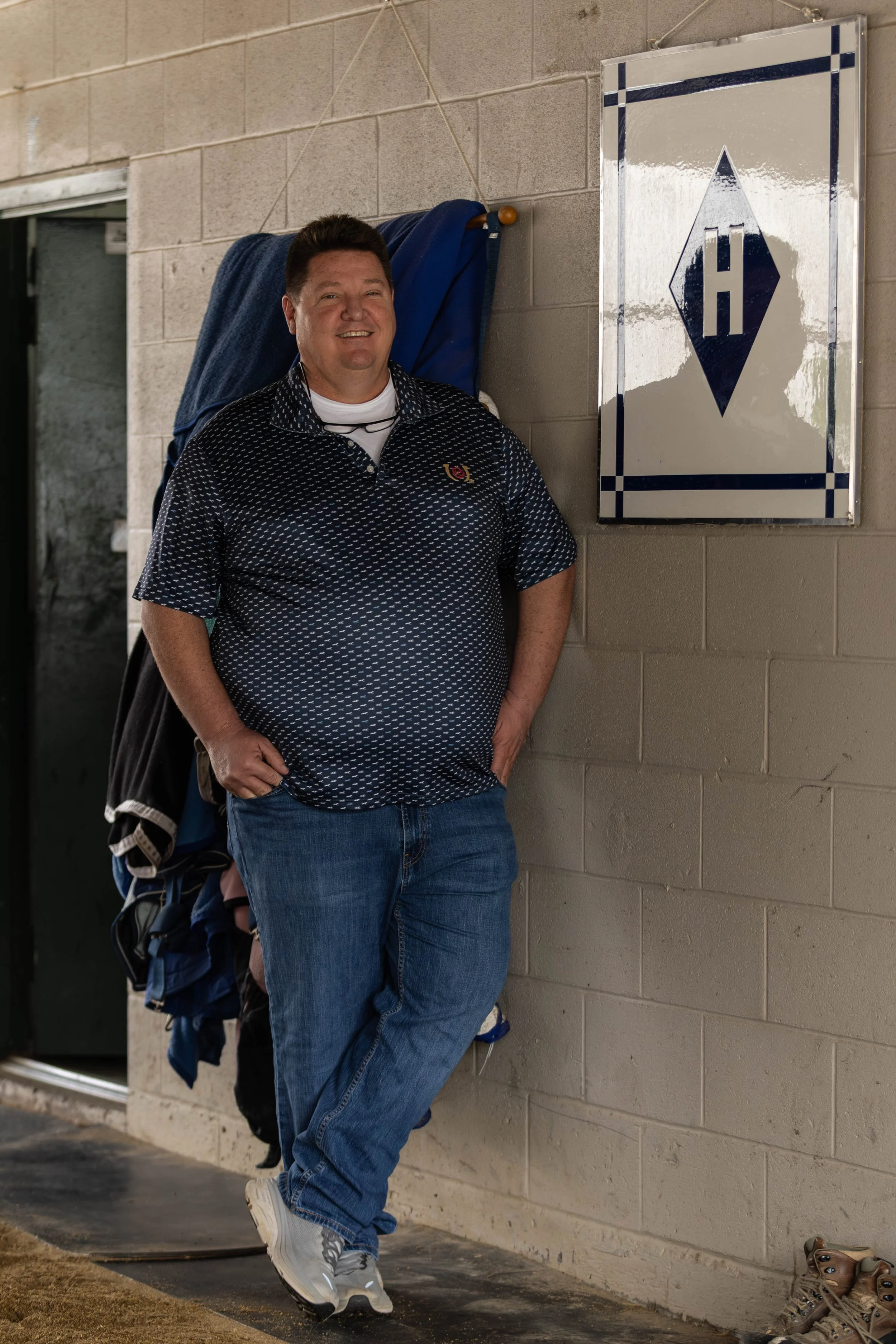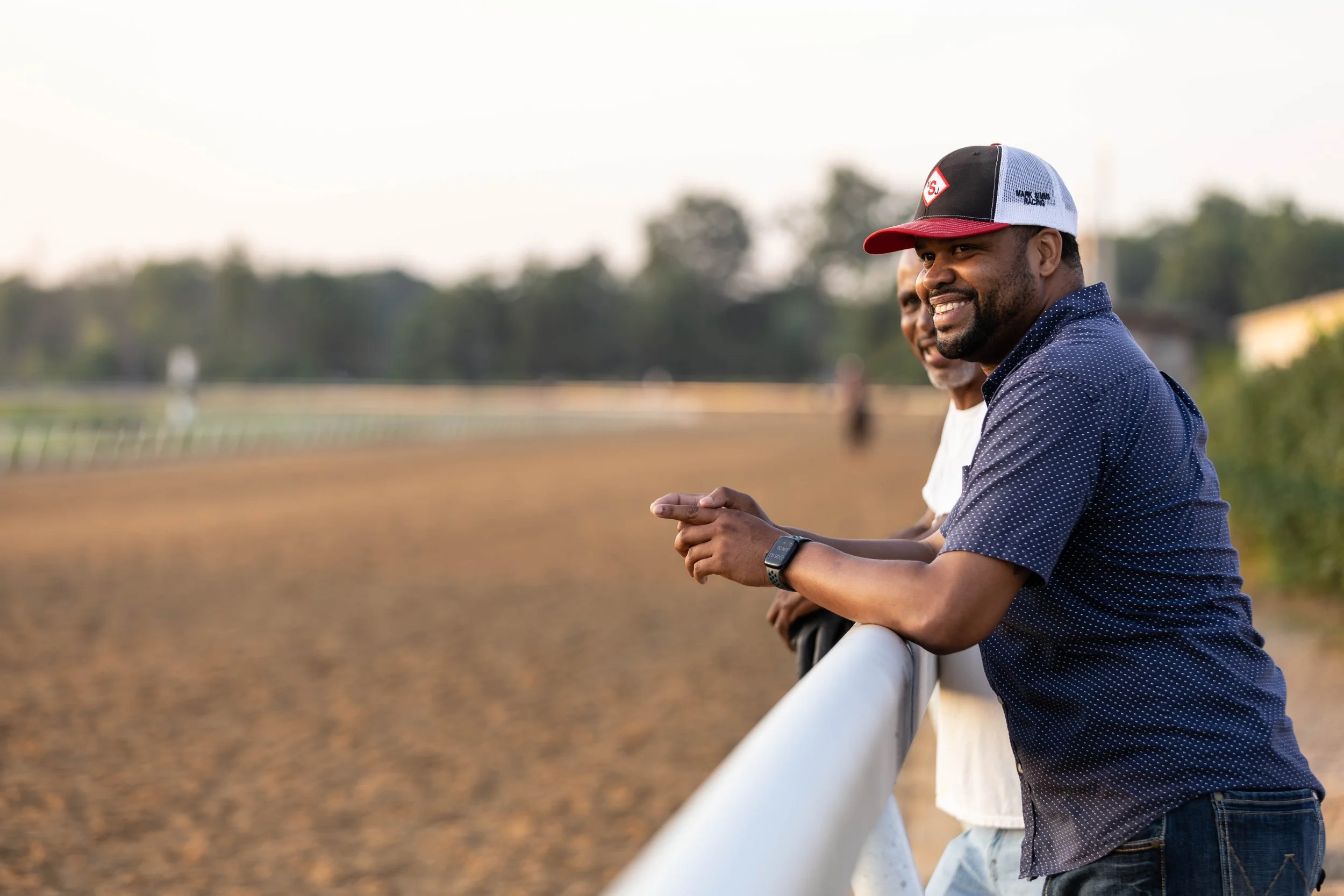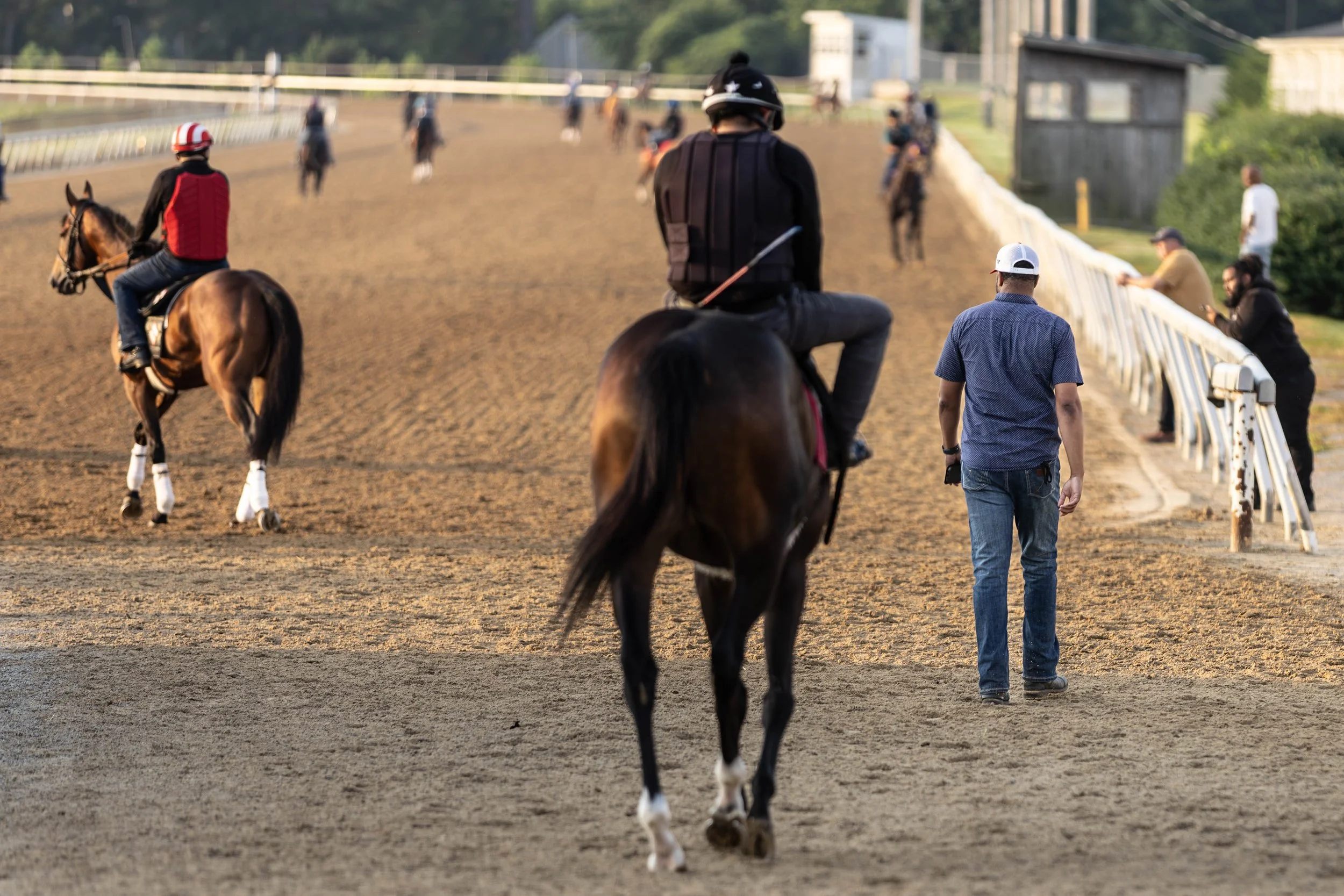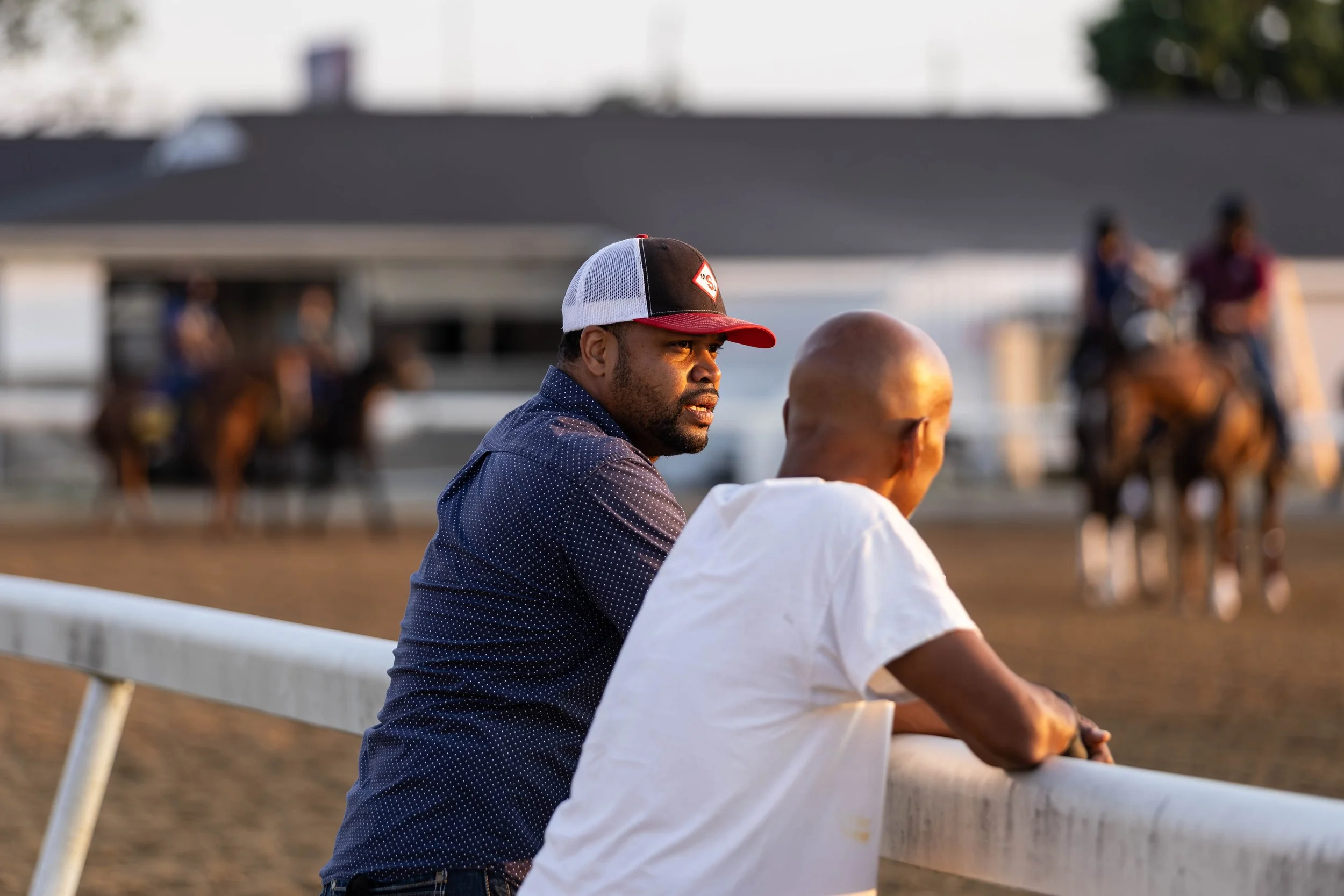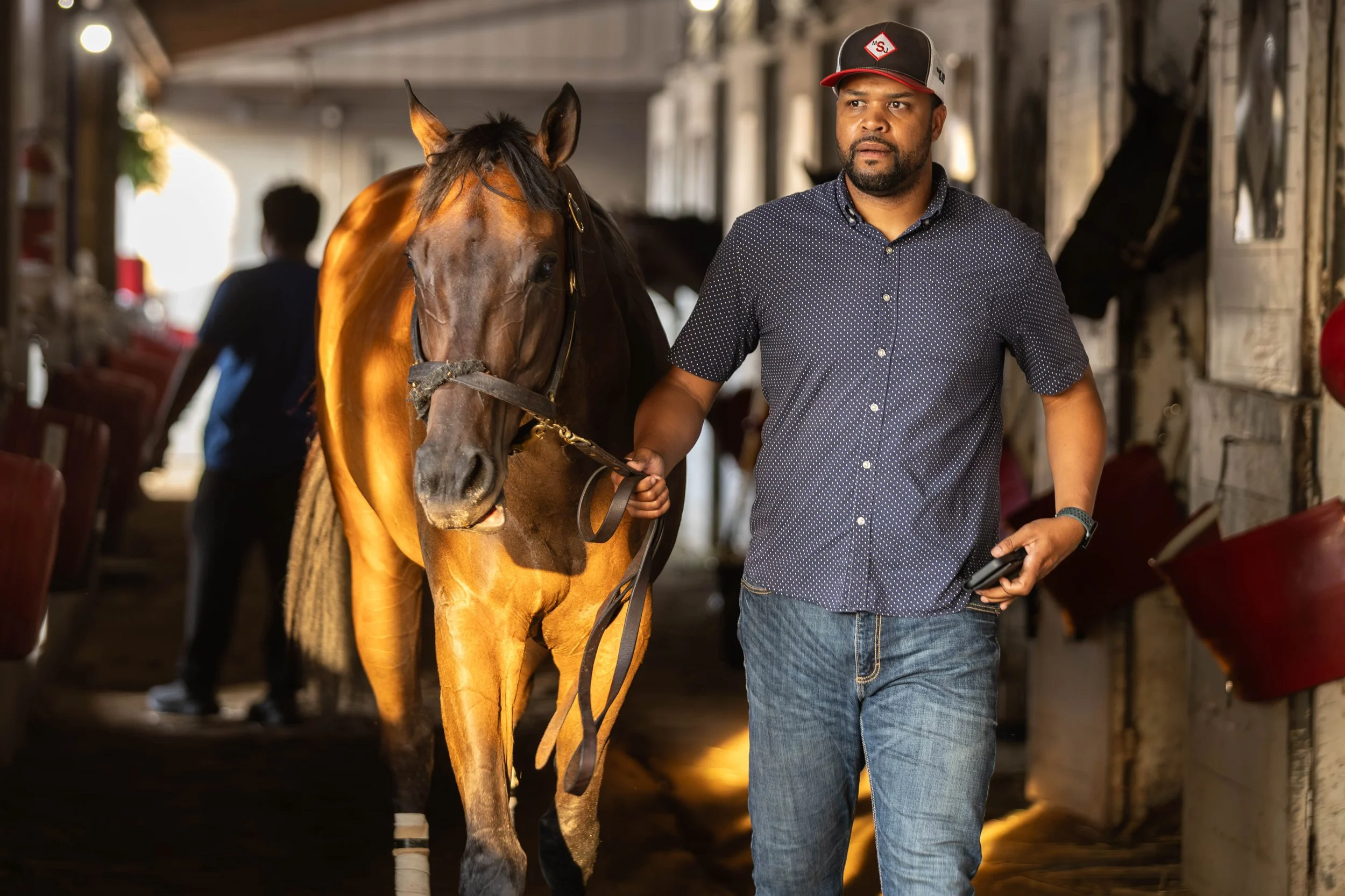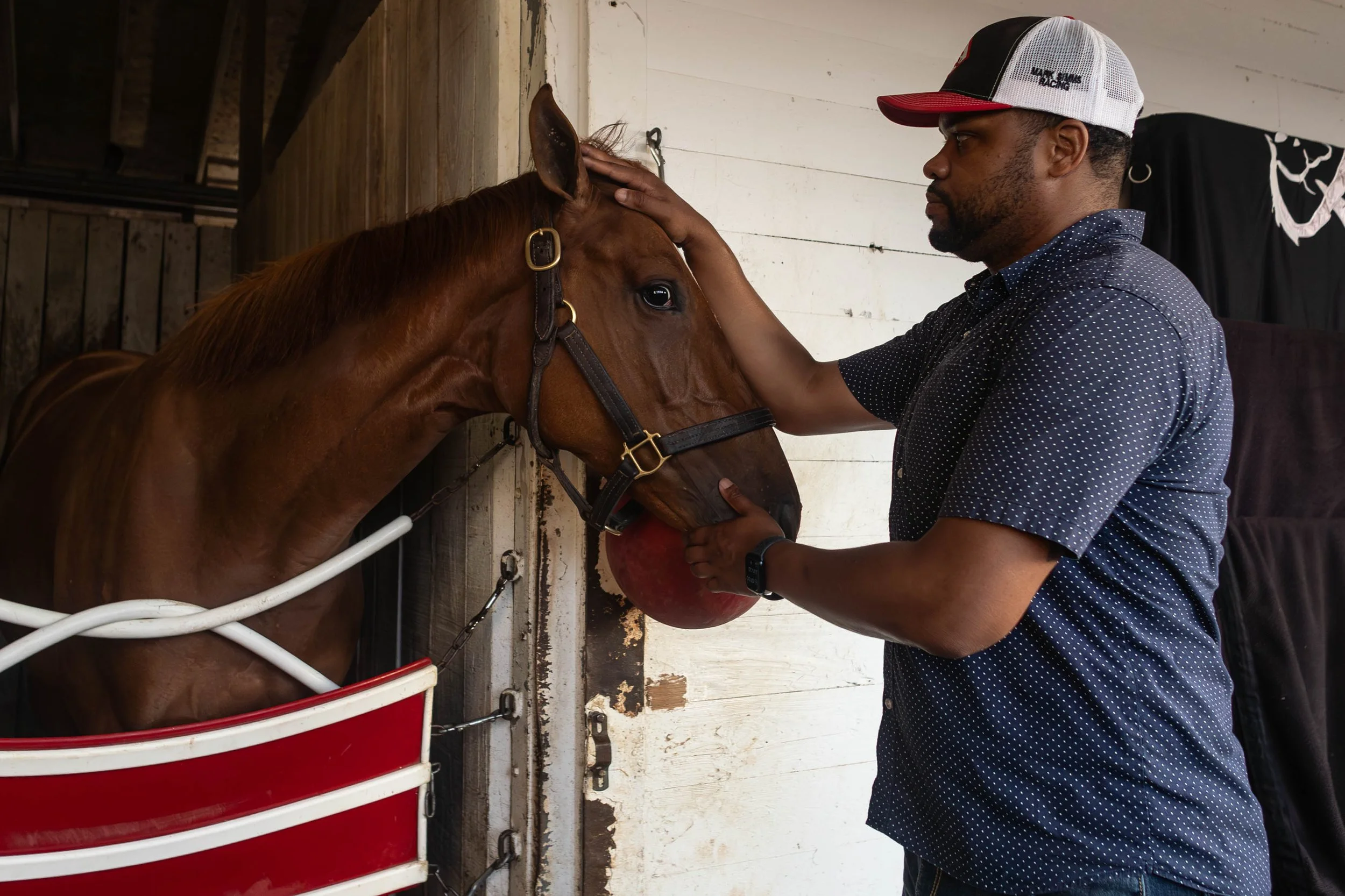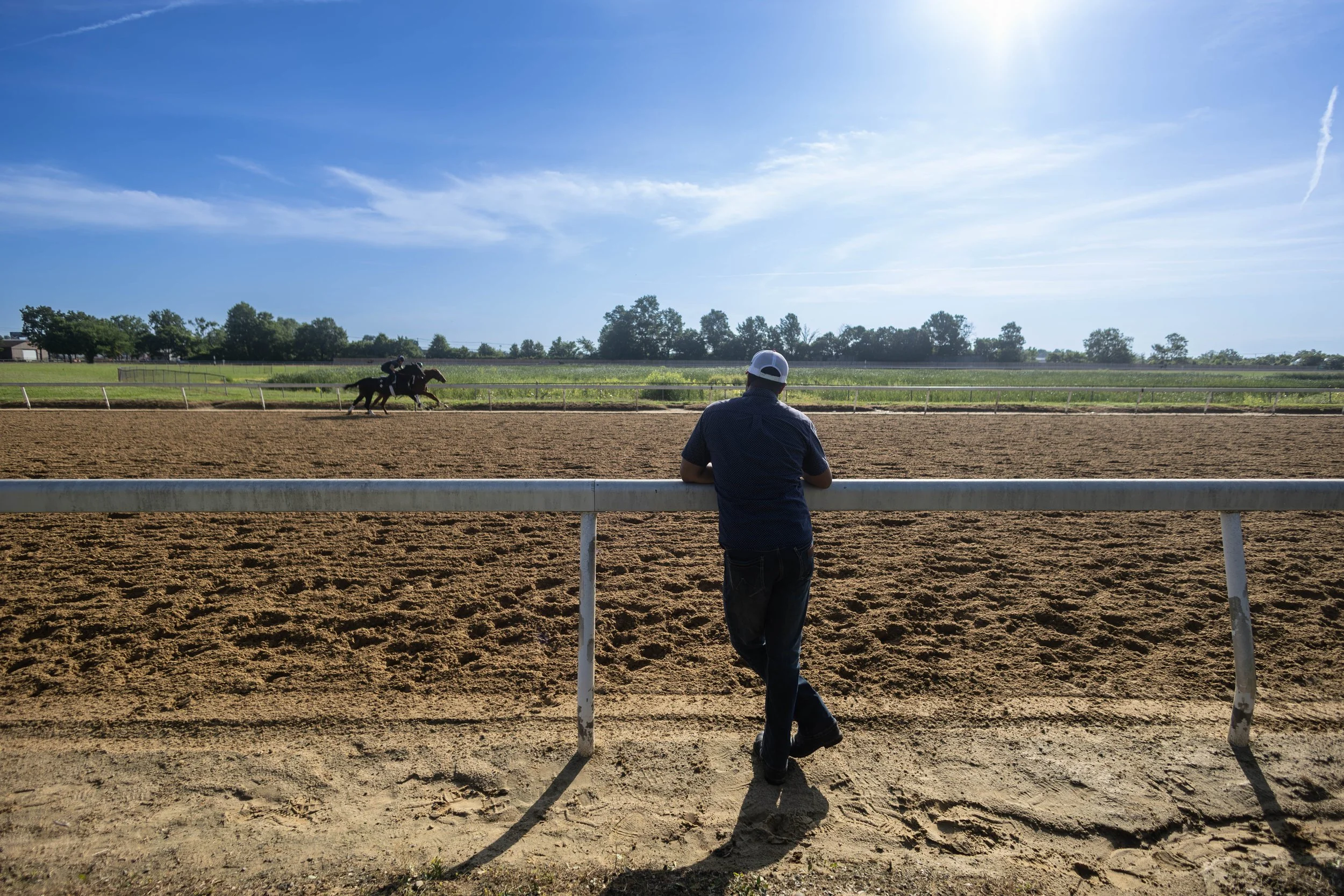Chris Hartman in profile - still learning and still winning
Article by Ken Snyder
Chris Hartman took a pass on high school. Got promoted to groom before he knew how to muck a stall. Blew right past the assistant trainer’s position to trainer. And then, he leapfrogged $3 million in earnings, going from $2.9 million in 2021 to $4.2 million in 2022. Earnings in both 2023 and 2024 exceeded $5 million.
His story is at least as remarkable as his ascent through Thoroughbred racing and really, through life.
He went to work on the racetrack at the ripe old age of 11, drawing his first paychecks not from his trainer-father Stan, but Molly Pearson at Prescott Downs.
”Molly’s mother had actually made her hire me. She said, ‘You need to hire this boy, he needs a job.” It was an idea Pearson wasn’t keen on. She didn't like the way he mucked stalls. When Molly told her mom of Hartman’s weakness with a muck fork and straw, her mother replied, “Well, that's good. Then he shouldn't be cleaning stalls anyway.’”
It was the beginning of his education in ground work.
Hartman and Molly Pearson would groom horses together and give him valuable experience. She was, in Hartman’s words, “quite a caretaker of her horses. She'd have me rubbing their legs, putting jell on their legs and putting wraps on them.”
Hartman, 52, doesn’t remember life without horses. “I grew up with Thoroughbreds in the backyard.” His boyhood was spent with his dad at Turf Paradise, the Arizona county fair circuit, or Prescott Downs (now Arizona Downs).
The road called to Hartman at age 15 when an exercise rider going to Minnesota from Arizona asked him if he wanted to go along with him. His response? “Hell, it sounds like fun.” It was the beginning of a jaunt that took him from Minnesota to Tampa Bay Downs and back up to Kentucky. ‘Fun,’ though, was secondary for Hartman.
“I wanted to learn everything I could about a horse. So I sort of moved a little bit,” understating it considerably. He built his future watching those around him, studying individual horses carefully, and putting into practice something his grandfather, also a trainer, said to him: “You should always be able to learn. You can’t know everything about a horse.
“To this day, I try to learn all I can.”
Learning from his own horses began for Hartman at age 14 when trainer Michael Freeman at Turf Paradise agreed to sell him a horse named Jat Alane for $300. When Hartman showed up at Freeman’s barn - lead shank, halter, and money in hand - the trainer told him he had changed mind on the deal. It was a ruse that got Hartman fuming. He was mad enough to tell Freeman his dad had warned him about “people like you.” The trainer relented with the put-on and the nixed deal; he gave the “youngster,” as he called Hartman, the horse. The transaction probably was part of Hartman later running the shedrow for Freeman when he was 16.
Hartman’s next purchase came when he noticed a horse cooling out on the backside after a race. “He’d just ran and he was running off with the hotwalker, so I knew the horse didn't give all he had in the race.” He approached the horse’s disgruntled trainer, Sheridan Majors, at probably just the right time. When Hartman asked about the horse, Fine Hostage, the trainer said, “’Give me five-hundred dollars and you can have this s.o.b.’ So I said, ‘I'll be right back.’ I went to my room and got the money and came back with it. That's how I got him.”
Hartman trained the horse off the poor performance list and won the second time out on December 28, 1990 when he was 17. “He paid one-hundred eighty-nine dollars. I was training horses but I wasn’t old enough to have a license, so the horses were in my dad's name.”
“When I was training that horse, I really wanted to figure it out for myself; was it really about the horse, or do you just need good horses, or do you have to go underneath somebody and be an assistant?”
Fine Hostage, indeed, helped Hartman ‘figure it out’ with another win in his fourth start for him on February 2, 1990.
At the time Hartman was working for another trainer, Dale Hunt, who bridled at an employee with his own horse.
“I had told him, ‘I'm gonna’ get a horse.’”
Hunt apparently thought Hartman wasn’t serious. After the acquisition, the inevitable happened with Hunt. “He told me, ‘I don't want you spending all your time with that horse,’ and I said, ‘Okay, that's fine. I'll give you my notice now. I'm going to be spending a lot of time with him. I guess you're gonna need somebody else.’
“He's like, ‘Whoa, whoa, you ain't got to be doing it like that.’”
The exchange, at least for Hartman, was strictly business without emotion. “I wasn’t upset with the guy. I had a game plan.”
The plan included leaving the Southwest for a stop at Churchill Downs where Hartman worked for trainer Johnny Tammaro as night watchman. That job took him from Louisville to Saratoga. A thousand dollars was stolen from his wallet - this soured Hartman. From Saratoga he returned to Arizona. It was the jumping off point for him as a trainer.
“I had the mindset, I was going to learn either how to train a horse or go back and just get a job when I was really of age to do it. The whole goal was just to see if I can make a horse as good as they can be, if they are good enough to win, regardless of what the form looks like.”
The training regimen, the feed, the close watch on health and injury are, of course, the primary tasks of a trainer. But Hartman applied an intangible that is easily discounted or dismissed that made him successful, first in the Southwest and now at Churchill Downs. And it might also take him into the national spotlight in the future.
“I've got a love for horses. There's no doubt about it. They're magnificent to me. I love to see them in flight, just running. When you know that a horse just gives you everything they've got when they run, it does something for me. I was very blessed in the fact that I was born into something that I really enjoy doing,” he said.
The desk in his office at Barn 48 at Churchill Downs is strategically placed for him to look down the shedrow at every stall on one side of his barn.
“I spend a lot of time here at the barn just looking down the shedrow. At eleven o'clock here, we feed them, and all their heads start to pop out from the stall door. They know, eleven is ‘din-din’ time. They'll start nickering when the feed starts coming. It's a good time.”
If there is a favorite aspect of training for Hartman it is learning the personality of each of his horses.
He talked about a filly in his barn he described first as “very difficult” before amending it quickly to “super difficult.” How “super”? She had ripped off her hind shoes loading in the horse trailer on the way to Hartman’s barn at Churchill Downs.
A cold water spa just across from Hartman’s barn presented another difficulty for the filly. Hartman smiles recounting a recent incident.
“She goes in that thing all the time. About every third day, though, she decides she wants ‘more attention,’” as he termed it. “The other day she was kicking, using her hind legs. I thought, ‘somebody's going to get hurt.’ I came over and stood behind her and just started nudging her. She stopped and turned her head to look at me, turned some more to look at me , and then she walked right in.
“That’s just her. That’s what she does.”
Difficult or easy, all of Hartman’s horses run and run often, a reputation which he earned early in his career and still earns.
“Your magazine says ‘Trainer,’ right? It doesn’t say ‘Stall.’ I think you gotta’ run them.” At the time of writing, the 30 horses he has currently at Churchill Downs have made 56 starts in 38 days of racing—not that far from two starters per day.
His absence of shyness around the entry box has paid dividends. His career win percentage is the same as racing luminary, trainer Steve Asmussen.
Despite that better-than-average win percentage, he dismisses statistics. “There are some real good trainers that are ten percent, twelve percent, and fifteen percent. I think people get a little too focused on the percent, not on the horse.” He goes so far as to say that a focus on statistics by trainers accounts for the increasing number of scratches and small fields. “They’re scared to run them because they want to keep their numbers up.”
The task, according to Hartman, is spending a lot of time determining where they run. Like any trainer, he likes to run his horses where they have a shot at winning but that doesn’t mean shipping a horse to a small track from Churchill Downs to improve chances of a win. “If I've got a horse that needs to be at Belterra (in Cincinnati) then they’ll be at Belterra,” making an oblique reference to trainers who shop for easy spots. He thinks it is one cause of smaller fields and more scratches at major tracks.
The path to the success Hartman has achieved to date began with his first venture to Lone Star Park outside Dallas. That’s where he introduced a newcomer, Joe Davis, to horse racing.
“He called me up and wanted to talk about getting in the game. He had never owned a horse.
“He was the first guy that really invested in a lot of horses with us, and that probably changed the direction for me.” Three straight wins for horses with Davis’s first three starters for Hartman didn’t hurt in cementing the relationship.
“Before, I was just plugging along, trying to get us in the Midwest.” Hartman has had as many as 45 horses owned by Davis in his barn through the years.
The other major boost to Hartman was giving Oaklawn Park a shot in 2013. In 77 starts in Hot Springs, Hartman horses won 16 races for an impressive 21% win rate and 12th place in trainer standings for the meeting.
The move was the beginning of “getting better horses and new owners.”
Of course, that doesn’t just happen. “If you’re winning races, owners will come.”
One new owner Hartman met at Oaklawn, James Driver, brought him 15 horses that the trainer knew were well-bought, solid horses.
“He had replaced his previous trainer and called me and said he wanted to make a switch,” recalled Hartman. “I was a little bit surprised. I thought they had a good thing going myself. I said to him, ‘Well, maybe you'll work it out with him.’
“I try to quiz someone a little bit, you know, to see what’s going on. Are they firing their previous trainer because, ‘I don't like the way he picks his races,’ or whatever. I’ll ask, ‘Well, where do you think they should run?’ And then you might find out the reason why they're firing the trainer is because they want to run them in allowance races. Well hell, it ain't gonna be much different with me. I want to find out what the guy's doing. What's the thinking? Is he firing the trainer just to make a change or is there a legit reason.”
This may go a long way in explaining the long relationships he has had with key clients and the success he has brought them. “Joe Davis told me, ‘Chris, we've been together longer than two of my marriages.’”
From Oaklawn, Hartman, a noted storyteller on the backside at Churchill Downs, employed ‘a little bit of convincing’ with some of his clients to give Kentucky and Churchill Downs a try in 2015.
“We had twelve horses for Driver and I thought they’d fit here,” said Hartman. He is still traveling the Churchill Downs-Oaklawn Park circuit each year. He also still has horses from both Davis and Driver.
What is next for Hartman? The last two $5 million-dollar years bode well for the future.
“You always have to go forward. I'm just trying to get better horses.”
The challenge he embraces to get the most from horses is something that has never left him. “I'll be honest, if I had fifty-two stake horses in the barn right now, and there's fifty-four stalls, I’d still have a couple claimers. I love trying to figure them out. Some people like to mess around with old cars, and I like to mess around with horses.”
And making them, of course, as good as they can be.
Stay tuned.
From the discipline of the battlefield to the demands of the backstretch - Mark Simms Jr. in profile
Article by Alicia Hughes
There is a level of ease that radiates off individuals fortunate enough to exist entirely within their element, an enviable calm that never waivers even when honing their craft in an industry designed to be a 365/24/7 grind.
Theirs is the kind of vibe that hangs like pollen in thick summer air and drapes itself all over those who enter their orbit, which explains why the far end of Barn E at Churchill Downs’ Trackside Training Center in Louisville is as much a sanctuary for its occupants as it is a hub for aspirations. Through every pass down the shedrow, every forelock that gets rubbed, every conversation had with a visitor, friend, or colleague, it becomes as obvious as the black and red sign with the white diamond out front.
Mark Simms, Jr. is exactly where he should be – the byproduct of having spent the brunt of his adult life forging a path toward what he believed was his inherent destination.
“For sure, this is definitely my passion,” the 36-year-old trainer said through a widening grin. “I was telling my wife the other day how relaxing it is to come to the barn. No matter what’s going on elsewhere, coming to the barn and being around the horses, it’s just super tranquil.”
Technically, there is little in the way of tranquility in the life of a Thoroughbred racehorse trainer. There is no off season, or real days off for that matter, and one’s entire livelihood hinges on the ability of 1,000-pound athletes supported by sinewy limbs as fragile as they are powerful.
Yet, from the time he took his first steps while trying to follow his grandfather to the barn to serving his country in the Army during tours of duty in Korea and Afghanistan, the demands of a life that revolves around equine athletes is what Simms sought the most. It was an ambition he chased even when the world presented him with chance after chance to settle into an illustrious career path he had already proven he could excel at.
Hence, as he goes about his morning routine in the barn with his name on it filled with horses owned by some of the most storied clients in the sport, the appreciation for his most challenging and rewarding journey to date is almost tangible.
There is a plethora of metrics used to measure success amongst trainers - win percentages, stakes victories, purse money, graded triumphs. While attaining lofty marks in those categories is as much as goal for Simms as it is for any of his comrades, the fact he found a pathway into an industry that doesn’t easily open doors for those who don’t descend from a certain ilk is as much an achievement as any piece of hardware from a Grade 1 test.
While he comes from a long line of horsemen, including his grandfather who was a trainer himself, Simms’ arrival at his current reality is one even Hollywood’s most creative screenwriters would be hard pressed to conjure. Born in Texas, he grew up on the Turtle Mountain Band of Chippewa Indian Reservation in North Dakota near Chippewa Downs racetrack, the product of a military family. Even as he followed in his parent’s footsteps - being in the Reserve Officers' Training Corps (ROTC) while enrolled in Virginia State University, becoming an Intelligence Officer and eventually rising to the rank of captain in the Army - fate always kept him close enough to horses to where he could never quell the zeal that had manifested since he took those first wobbly strides toward his grandfather’s stable.
To sign up for such a vocation requires an uncommon passion, discipline, faith, and work ethic lest one get devoured by the unyielding highs and lows that are the sport’s hallmarks. To keep chasing a dream that promised to do nothing but test those intangibles at every point of call demanded something as unique from Simms as his backstory itself.
“I always wanted to train horses; I knew that. Training horses, being around horses is really all I ever wanted to do…but I really didn’t think it was feasible there for a while,” Simms said. “Even throughout my time in the Army, I was always trying to get close to the horses, but I just didn’t have a path to get in. Horse racing, especially in Kentucky, it’s super inbred to where people’s dads were trainers, their moms were trainers, or they were tied to a farm. Really, my way in was being in the military.”
During his freshman year at Virginia State University, as he began studying toward the degree in Criminal Justice and minor in Animal Science he would ultimately graduate with, Simms worked at a nearby horse farm in his free time to try and satiate his lifelong calling, a move most of his acquaintances dismissed as a pipedream.
He did have a certain individual in his corner, however, encouraging him not to let his passion project become just that.
“I met my wife in college our freshman year and I was working at a farm just to be close to the horses,” Simms said of his wife, Shayla who works as a Pediatric Intensive Care Unit nurse. “I would tell people ‘I want to train horses’ and everyone was like ‘You’re crazy’. But she was really the first person to really be like ‘You can do this’. That’s how I knew she was the one.
“She would buy me books about horse racing and just horses in general just to show her support. That’s when the gears started turning a bit. But I did ROTC, so I knew after college I was going to be an officer in the Army.”
As a result of being in the top 2% of cadets in the nation, Simms got to choose which branch of the Army he wanted to go into. He settled on Korea first in 2011 and while there, would find his way to the racetracks on the weekends all while keeping tabs on the major goings on with the sport back home. When the time came for him to pick a new duty station, he chose an infantry brigade in Fort Knox, Kentucky that was getting set to deploy to Afghanistan.
Once the papers came through saying he was officially being assigned to the Bluegrass State, putting him less than an hour’s drive from Churchill Downs, Simms leaned into the opportunity and began reaching out to trainers about the possibility of gaining the experience necessary to advance his dream while simultaneously advancing his career.
“I tell people all the time, the Army made the mistake of sending me to Fort Knox,” Simms laughed. “I got close to racehorses again.”
While Thoroughbred racing is littered with those who think they want to delve into the industry only to get a rude awakening when ensconced in the unyielding nature of the business, the discipline embedded in Simms as a result of his background caught the attention of one of the sport’s more heralded barns. Louisville native Dale Romans, who earned the Eclipse Award in 2012 as the nation’s outstanding trainer, had a member of his staff at the time in Tari Hendrickson who herself had family in the military.
She responded to Simms’ email by telling him he was free to report to Romans' training center in Goshen once he reported for duty.
“On the weekends and even sometimes during the week, because I didn’t have to be in the office until like 9 a.m., I would get up at 4 a.m. drive up there to Goshen, train horses in the morning, take a shower, throw on my uniform, and go to work,” Simms recalled. “And when I got back from Afghanistan (in 2014), I started thinking ‘I can do this.’”
Over the course of the next four years, Simms would establish himself as an assistant to Romans while also holding down a job at GE (General Electric), heading to the barn before work and helping to hone the likes of such proteges as Travers Stakes winner Keen Ice, fellow Grade 1 winners Brody’s Cause and Free Drop Billy, and future top sire Not This Time. Though horsemanship had long been a part of his DNA, getting to be around top-level runners and learning how to develop them into such was an invaluable piece of the puzzle Simms couldn’t get enough of.
“He’s got the work ethic of a military man. He got to see a lot of things, a lot of good horses and figure out what he needed to do,” Romans said of Simms. “The horse stuff isn’t brain surgery and a smart guy like Mark can learn all of that pretty quick. It’s all the stuff around it that can be difficult, but he seems to have a good knack for that. A lot of people show up thinking they love horses when what they really like is horse racing, and those can be two different things. And Mark obviously has a love for the horse. It really seems like it has enriched his life.”
Days before the 2017 Preakness Stakes, Simms’s grandfather Michael Nelson – the one who told him he needed to walk on his own if he wanted to join him in the barn - passed away. Soon after, Simms decided the time had come for him to take his most definitive solo steps yet.
“When he passed, I was like, man I have to at least give it a shot,” Simms said.
Despite the fact the foundations of the sport were built on the backs of the African-American community, many of the racist ideologies that drove Black horsemen out during the Jim Crow era still resonate to this day. Where Black jockeys and trainers once reigned over the sport’s greatest prizes – with Black reinsmen winning 15 of the Kentucky Derby's first 28 runnings and Hall of Famers like Ed Brown among the most accomplished horsemen of his time – the opportunity to have an opportunity is something that remains scarce for Black, Indigenous, and People of Color individuals in Thoroughbred racing.
It is something Simms doesn’t like to dwell on but also can’t help but be aware of ever since he took the leap and began training on his own in 2017, becoming one of few Black trainers currently in the sport. About three years ago, he gained the support of historic Calumet Farm as his main client, a relationship that has been fruitful ever since Simms claimed a son of Candy Ride (ARG) by the name of Kaziranga off them in 2019 and went on to earn his first Churchill Downs win with the gelding two starts later.
Surreal as it is that he is on the same Calumet email list as the Todd Pletchers and Chad Browns of the world, Simms knows he shoulders a different kind of burden every time he walks into a paddock to saddle one of his own.
“Whenever I have someone new or a buddy come to town, I always show them the (Kentucky Derby) mural at Churchill Downs and how it started as all Black trainers and all Black jockeys and how we transitioned away from it,” Simms said. “It does weigh on me. I’m always thinking about maybe I can open a door for someone else and show people that we can still do it.
“I’m a firm believer that I’m an opportunity or a horse away from things taking off. But with young people in the sport in general, unless someone knows your name or you’re intertwined, you don’t get as many opportunities as some of the other folks,” Simms continued. “Another thing is a lot of people are comfortable with folks who look like them and unfortunately, there aren’t a lot of Black owners. It’s hard, it’s a challenge. But I do see a glimmer in some of these older Black grooms. They see me and say, ‘Oh you’re a trainer?’ I can see a light in their eyes. I can see the hope.”
They also see genuine potential. In 2023, Simms saddled 78 starters who earned more than $400,000, both career highs. His current equine roster numbers at a dozen and, if he could get the stars to align just so, he would like to pick up a couple more claiming outfits, get his number of trainees up to the 30-40 range, and start making some real noise with the 2-year-olds in his care.
“I don’t think I would want to be like those guys who have 200-300 horses,” he said. “Those guys do a phenomenal job, but I would prefer quality over quantity just because I want to be hands on.”
“His history with horses is equal to his passion for them. We are certain he will be a major player in American horse racing going forward,” Calumet Farm added in a statement.
With added time and chances will come more positive numbers. Regardless of the statistics, however, it is evident Simms is flourishing.
When his wife went into labor with their second child, the timing was such that they both agreed to swing by his barn on the way to the hospital to make sure the other youngsters dependent on him were well situated.
“And then on the way home, we stopped at the barn and brought the baby into the barn and made sure everything was good,” Simms said.
For the better part of the last decade, things couldn’t be much better for Simms. He has manifested the position in life he always dreamt for himself.
And he couldn’t be more at ease.
“I've had several opportunities to do other things, but the horses have been my passion, and I wake up every day and thank the good Lord that I get to pursue my passion,” he said. “I think there are a lot of really good horse trainers out here that just don't have the athletes. I’m just hoping some of us can get some more opportunities.”


